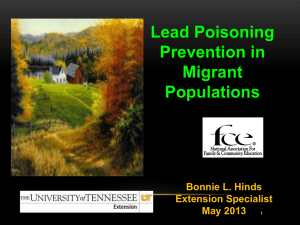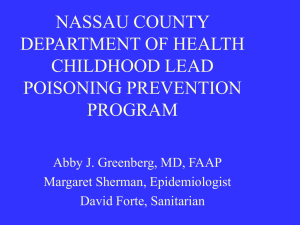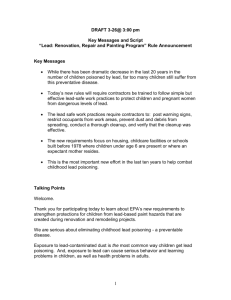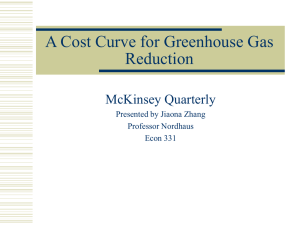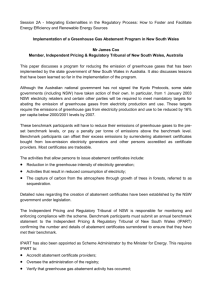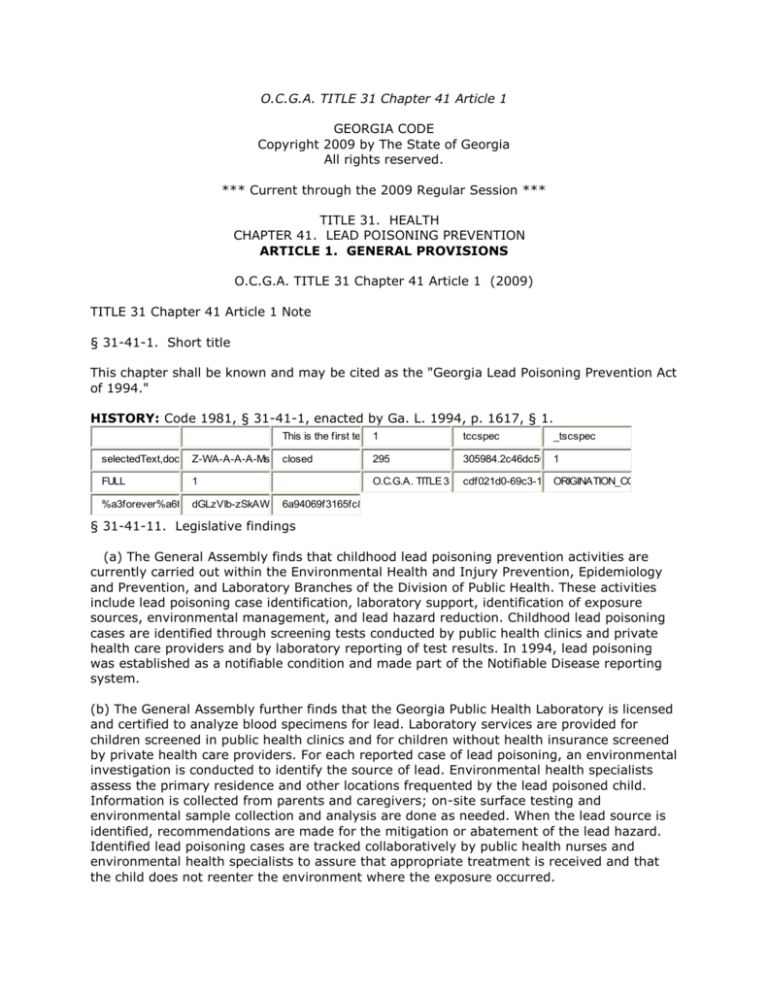
O.C.G.A. TITLE 31 Chapter 41 Article 1
GEORGIA CODE
Copyright 2009 by The State of Georgia
All rights reserved.
*** Current through the 2009 Regular Session ***
TITLE 31. HEALTH
CHAPTER 41. LEAD POISONING PREVENTION
ARTICLE 1. GENERAL PROVISIONS
O.C.G.A. TITLE 31 Chapter 41 Article 1 (2009)
TITLE 31 Chapter 41 Article 1 Note
§ 31-41-1. Short title
This chapter shall be known and may be cited as the "Georgia Lead Poisoning Prevention Act
of 1994."
HISTORY: Code 1981, § 31-41-1, enacted by Ga. L. 1994, p. 1617, § 1.
selectedText,doc
Z-WA-A-A-A-Ms
FULL
1
%a3forever%a6t
dGLzVlb-zSkAW
This is the first te
1
tccspec
closed
295
305984.2c46dc50 1
O.C.G.A. TITLE 31 cdf021d0-69c3-1
_tscspec
ORIGINATION_CO
6a94069f3165fc8
§ 31-41-11. Legislative findings
(a) The General Assembly finds that childhood lead poisoning prevention activities are
currently carried out within the Environmental Health and Injury Prevention, Epidemiology
and Prevention, and Laboratory Branches of the Division of Public Health. These activities
include lead poisoning case identification, laboratory support, identification of exposure
sources, environmental management, and lead hazard reduction. Childhood lead poisoning
cases are identified through screening tests conducted by public health clinics and private
health care providers and by laboratory reporting of test results. In 1994, lead poisoning
was established as a notifiable condition and made part of the Notifiable Disease reporting
system.
(b) The General Assembly further finds that the Georgia Public Health Laboratory is licensed
and certified to analyze blood specimens for lead. Laboratory services are provided for
children screened in public health clinics and for children without health insurance screened
by private health care providers. For each reported case of lead poisoning, an environmental
investigation is conducted to identify the source of lead. Environmental health specialists
assess the primary residence and other locations frequented by the lead poisoned child.
Information is collected from parents and caregivers; on-site surface testing and
environmental sample collection and analysis are done as needed. When the lead source is
identified, recommendations are made for the mitigation or abatement of the lead hazard.
Identified lead poisoning cases are tracked collaboratively by public health nurses and
environmental health specialists to assure that appropriate treatment is received and that
the child does not reenter the environment where the exposure occurred.
HISTORY: Code 1981, § 31-41-11, enacted by Ga. L. 2000, p. 1260, § 1.
(16) "Lead project designer" means a person who plans or designs abatement activities
and interim controls.
(17) "Lead risk assessor" means a person who conducts on-site risk assessments of lead
hazards.
(18) "Lead supervisor" means a person who supervises and conducts abatement of leadbased paint hazards.
(19) "Lead worker" means any person performing lead hazard reduction activities.
(20) "Risk assessment" means an on-site investigation to determine and report the
existence, nature, severity, and location of lead-based paint hazards in or on any structure
or site, including:
(A) Information gathering regarding the age and history of the structure and the
occupancy or other use by young children;
(B) Visual inspection;
(C) Limited wipe sampling or other environmental sampling techniques;
(D) Other activity as may be appropriate; and
(E) Provision of a report explaining the results of the investigation.
HISTORY: Code 1981, § 31-41-3, enacted by Ga. L. 1994, p. 1617, § 1; Ga. L. 1998, p.
248, § 1.
§ 31-41-4. Establishment of lead-based paint hazard reduction program; training
programs; licensure and certification requirements; standards.
(a) There is established the Georgia Lead-Based Paint Hazard Reduction Program. The
Department of Natural Resources is designated as the state agency responsible for
implementation, administration, and enforcement of such program. The commissioner may
delegate such duties to the Environmental Protection Division.
(b) The Board of Natural Resources not later than one year after the effective date of
regulations promulgated by the federal Environmental Protection Agency relating to lead
paint abatement certification programs shall issue regulations requiring the development
and approval of training programs for the licensing or certification of persons performing
lead-based paint hazard detection or lead-based paint activities, which may include, but
shall not be limited to, lead inspectors, lead risk assessors, lead project designers, lead
firms, lead supervisors, and lead workers of such persons. The regulations for the approval
of training programs shall include minimum requirements for approval of training providers,
curriculum requirements, training hour requirements, hands-on training requirements,
examinations of competency and proficiency, and training program quality control. The
approval program shall provide for reciprocal approval of training programs with comparable
requirements approved by other states or the United States. The approval program may be
designed to meet the minimum requirements for federal approval under Section 404 of the
federal Toxic Substances Control Act and the department may apply for such approval. The
department shall establish fees for approval of such training programs.
(c) (1) The Board of Natural Resources not later than one year after the effective date of
regulations promulgated by the federal Environmental Protection Agency relating to lead
paint abatement certification programs shall establish training and licensure requirements
for lead inspectors, lead risk assessors, lead project designers, lead firms, lead supervisors,
and lead workers. No person shall be licensed under this chapter unless such person has
successfully completed the appropriate training program, passed an examination approved
by the department for the appropriate category of license, and completed any additional
requirements imposed by the board by regulation. The department is authorized to accept
any lead-based paint hazard training completed after January 1, 1990, in full or partial
satisfaction of the training requirements. The board may establish requirements for periodic
refresher training for all licensees as a condition of license renewal. The board shall
establish examination fees, license fees, and renewal fees for all licenses issued under this
chapter, provided that such fees shall reflect the cost of issuing and renewing such licenses,
regulating licensed activities, and administering the program.
(2) On and after the effective date of regulations promulgated by the board as provided in
subsection (b) of this Code section, no person shall perform or represent that such person is
qualified to perform any lead-based paint activities unless such person possesses the
appropriate licensure or certification as determined by the board or unless such person is:
(A) An owner performing abatement upon that person's own residential property, unless
the residential property is occupied by a person or persons other than the owner or the
owner's immediate family while these activities are being performed, or a child residing in
the building has been identified as having an elevated blood lead level;
(B) An employee of a property management company doing routine cleaning and
repainting upon property managed by that company where there is insignificant damage,
wear, or corrosion of existing lead-containing paint or coating substances; or
(C) An owner routinely cleaning or repainting his or her property where there is
insignificant damage to, wear of, or corrosion of existing lead-containing paint or coating
substances.
(3) A person who is employed by a state or county health department or state or federal
agency to conduct lead investigations to determine the sources of lead poisonings, as
determined by the department, shall be subject to licensing pursuant to paragraph (2) of
this subsection as a lead risk assessor but shall not be required to pay any fees as otherwise
required under this chapter or under rules and regulations promulgated by the board under
this chapter.
(d) The board shall promulgate regulations establishing standards of acceptable professional
conduct for the performance of lead-based paint activities, as well as specific acts and
omissions that constitute grounds for the reprimand of any licensee, the suspension,
modification, or revocation of a license, or the denial of issuance or renewal of a license.
HISTORY: Code 1981, § 31-41-4, enacted by Ga. L. 1994, p. 1617, § 1; Ga. L. 1996, p.
1140, § 1; Ga. L. 1998, p. 248, § 2.
§ 31-41-5. Enforcement of chapter; violations
The Board of Natural Resources shall be authorized to promulgate all necessary
regulations for the implementation and enforcement of this chapter. In addition to any
action which may be taken to reprimand a licensee or to revoke or suspend a license, any
person who violates any provision of this chapter or any regulation promulgated pursuant to
this chapter or any term or condition of licensure may be subject to a civil penalty of not
more than $10,000.00, to be imposed by the department. If any violation is a continuing
one, each day of such violation shall constitute a separate violation for the purpose of
computing the applicable civil penalty.
HISTORY: Code 1981, § 31-41-5, enacted by Ga. L. 1994, p. 1617, § 1; Ga. L. 1996, p.
1140, § 2.
Title Note
Chapter Note
Article Note
§ 31-41-6. Federal regulations; fees; corrective orders; violations
(a) The department shall make available to all persons licensed or certified under this
chapter current federal regulations affecting such licensees or certified persons.
(b) The department is authorized to charge an application fee, a license fee, a license
renewal fee, or a similar fee and the amount of such fees shall be established by the Board
of Natural Resources. Each fee so established shall be reasonable and shall be determined in
such a manner that the total of the fees charged shall approximate the total of the direct
and the indirect costs to the state of the operation of the licensing program. Fees may be
refunded for good cause as determined by the department.
(c) The department is authorized to issue a corrective order to any person in violation of
this chapter or any regulation promulgated pursuant thereto. The order shall specify the
provisions of this chapter or any regulation alleged to have been violated and shall order
necessary corrective action be taken within a reasonable time to be prescribed in such
order.
(d) The department is authorized to revoke or suspend any license, certification, approval,
or accreditation issued hereunder in accordance with regulations promulgated pursuant to
this chapter.
(e) It shall be unlawful for any person to engage in training or lead-based paint activities
regulated under this chapter except in such a manner as to conform to and comply with this
chapter and all applicable regulations and orders established under this chapter.
(f) Any person violating any of the provisions of this chapter shall be guilty of a
misdemeanor.
HISTORY: Code 1981, § 31-41-6, enacted by Ga. L. 1994, p. 1617, § 1; Ga. L. 1998, p.
248, § 3.
GEORGIA CODE
Copyright 2009 by The State of Georgia
All rights reserved.
*** Current through the 2009 Regular Session ***
TITLE 31. HEALTH
CHAPTER 41. LEAD POISONING PREVENTION
ARTICLE 2. CHILDHOOD LEAD EXPOSURE CONTROL
O.C.G.A. § 31-41-10 (2009)
§ 31-41-10. Short title
This article shall be known and may be cited as the "Childhood Lead Exposure Control
Act."
HISTORY: Code 1981, § 31-41-10, enacted by Ga. L. 2000, p. 1260, § 1.
Title Note
Chapter Note
§ 31-41-11. Legislative findings
(a) The General Assembly finds that childhood lead poisoning prevention activities are
currently carried out within the Environmental Health and Injury Prevention, Epidemiology
and Prevention, and Laboratory Branches of the Division of Public Health. These activities
include lead poisoning case identification, laboratory support, identification of exposure
sources, environmental management, and lead hazard reduction. Childhood lead poisoning
cases are identified through screening tests conducted by public health clinics and private
health care providers and by laboratory reporting of test results. In 1994, lead poisoning
was established as a notifiable condition and made part of the Notifiable Disease reporting
system.
(b) The General Assembly further finds that the Georgia Public Health Laboratory is licensed
and certified to analyze blood specimens for lead. Laboratory services are provided for
children screened in public health clinics and for children without health insurance screened
by private health care providers. For each reported case of lead poisoning, an environmental
investigation is conducted to identify the source of lead. Environmental health specialists
assess the primary residence and other locations frequented by the lead poisoned child.
Information is collected from parents and caregivers; on-site surface testing and
environmental sample collection and analysis are done as needed. When the lead source is
identified, recommendations are made for the mitigation or abatement of the lead hazard.
Identified lead poisoning cases are tracked collaboratively by public health nurses and
environmental health specialists to assure that appropriate treatment is received and that
the child does not reenter the environment where the exposure occurred.
HISTORY: Code 1981, § 31-41-11, enacted by Ga. L. 2000, p. 1260, § 1.
§ 31-41-12. Definitions
As used in this article, the term:
(1) "Confirmed lead poisoning" means a confirmed concentration of lead in whole blood
equal to or greater than 20 micrograms of lead per deciliter for a single test or between 15
and 19 micrograms of lead per deciliter in two tests taken at least three months apart.
(2) "Day-care facility" means a structure or structures used as a school, nursery, child
care center, clinic, treatment center, or other facility serving the needs of children under six
years of age including the grounds, any outbuildings, or other structures appurtenant to the
facility.
(3) "Division" means the Division of Public Health.
(4) "Dwelling," "dwelling unit," or "residential housing unit" means the interior of a
structure, all or part of which is designed or used for human habitation.
(5) "Elevated blood lead level" means a blood lead concentration of ten micrograms per
deciliter or greater as determined by the lower of two consecutive blood tests within a sixmonth period.
(5.1) "Lead hazard abatement" means the removal and correction, in a manner no more
strict than what is determined to be absolutely necessary, of a specifically identified hazard
which causes a confirmed lead poisoning.
(6) "Lead poisoning hazard" means the presence of readily accessible or mouthable leadbearing substances measuring 1.0 milligram per square centimeter or greater by X-ray
fluorescence or 0.5 percent or greater by chemical analysis; 100 micrograms per square
foot or greater for dust on floors; 500 micrograms per square foot or greater for dust on
window sills.
(7) "Lead safe housing" is housing that was built since 1978 or that has been tested by a
person who has been licensed or certified by the Board of Natural Resources to perform
such testing and either found to have no lead-based paint hazards within the meaning of
Title X of the Residential Lead-Based Paint Hazard Reduction Act of 1992, 14 U.S.C. Code
Section 185(b)(15) or housing that has been found to meet the requirements of the
maintenance standard.
(8) "Maintenance standard" means the following:
(A) Repairing and repainting areas of deteriorated paint inside a residential housing
unit;
(B) Cleaning the interior of the unit to a standard of cleaning which is at least
customary in the local area at lease origination or as part of the abatement plan, whichever
is first, to remove dust that constitutes a lead poisoning hazard;
(C) Adjusting doors and windows to minimize friction or impact on surfaces;
(D) Subject to the occupant's approval, appropriately cleaning any carpets at lease
origination or as part of the abatement plan, whichever is first;
(E) Taking such steps as are necessary to ensure that all interior surfaces on which dust
might collect are readily cleanable; and
(F) Providing the occupant or occupants all information required to be provided under
the Residential Lead-Based Paint Hazard Reduction Act of 1992 and amendments thereto.
(9) "Managing agent" means any person who has charge, care, or control of a building or
part thereof in which dwelling units or rooming units are leased.
(10) "Mouthable lead-bearing substance" means any substance on surfaces or fixtures
five feet or less from the floor or ground that form a protruding corner or similar edge,
protrude one-half inch or more from a flat wall surface, or are freestanding and contain lead
contaminated dust at a level that constitutes a lead poisoning hazard. Mouthable surfaces or
fixtures include vinyl miniblinds, doors, door jambs, stairs, stair rails, windows, window sills,
and baseboards.
(11) "Persistent elevated blood lead level" means a blood lead concentration of 15 to 19
micrograms per deciliter as determined by the lowest of three consecutive blood tests. The
first two blood tests shall be performed within a six-month period, and the third blood test
shall be performed at least 12 weeks and not more than six months after the second blood
test.
(12) "Readily accessible lead-bearing substance" means any substance containing lead at
a level that constitutes a lead poisoning hazard which can be ingested or inhaled by a child
under six years of age. Readily accessible substances include deteriorated paint that is
peeling, chipping, cracking, flaking, or blistering to the extent that the paint has separated
from the substrate. Readily accessible substances also include paint that is chalking.
(13) "Regularly visits" means presence at a dwelling, dwelling unit, school, or day-care
facility for at least two days a week for more than three hours per day.
(14) "Supplemental address" means a dwelling, dwelling unit, school, or day-care facility
where a child with a persistent elevated blood lead level or a confirmed lead poisoning
regularly visits or attends. Supplemental address also means a dwelling, school, or day-care
facility where a child resided, regularly visited, or attended within the six months
immediately preceding the determination of a persistent elevated blood lead level or a
confirmed lead poisoning.
HISTORY: Code 1981, § 31-41-12, enacted by Ga. L. 2000, p. 1260, § 1; Ga. L. 2008, p.
822, § 1/HB 1043.
§ 31-41-13. Notice of lead poisoning hazard
Upon determination that a lead poisoning hazard exists, the division shall give written notice
of the lead poisoning hazard to the owner of the dwelling, dwelling unit, school, or day-care
facility and to all persons residing in or attending the dwelling or facility. The division shall
also make every reasonable and practicable effort to provide written notice to the managing
agent of the dwelling, dwelling unit, school, or day-care facility. The written notice to the
owner, managing agent, or tenant shall include a list of possible methods of abatement of
the lead poisoning hazard.
HISTORY: Code 1981, § 31-41-13, enacted by Ga. L. 2000, p. 1260, § 1; Ga. L. 2008, p.
822, § 2/HB 1043.
§ 31-41-14. Abatement of lead poisoning hazard
(a) Upon determination that a child less than six years of age has a confirmed lead
poisoning and that the child resides in, attends, or regularly visits a dwelling, dwelling unit,
school, or day-care facility containing lead poisoning hazards, the division shall require a
lead hazard abatement. The division shall also require a lead hazard abatement at the
supplemental addresses of a child less than six years of age with a confirmed lead
poisoning. Upon confirming that all other potential sources of the confirmed lead poisoning
have tested negative and making every reasonable effort to obtain consent from such
dwelling's owner or managing agent to comply with this Code section, the division shall
solicit a court order from the superior court with jurisdiction over such dwelling to order the
dwelling's owner to perform a lead hazard abatement.
(b) When abatement is required under subsection (a) of this Code section, the owner or
managing agent shall submit a written lead poisoning hazard abatement plan to the division
within 14 days of receipt of the lead poisoning hazard notification and shall obtain written
approval of the plan prior to initiating abatement. The lead poisoning hazard abatement
plan shall comply with subsection (g) of this Code section. The written plan shall be deemed
approved if the division does not respond within 14 days of receipt.
(c) If the abatement plan submitted fails to meet the requirements of this Code section, the
division shall issue an abatement order requiring submission of a modified abatement plan.
The order shall indicate the modifications which shall be made to the abatement plan and
the date by which the plan as modified shall be submitted to the division.
(d) If the owner or managing agent does not submit an abatement plan within 14 days, the
division shall issue an abatement order requiring submission of an abatement plan within
five days of receipt of the order.
(e) The owner or managing agent shall notify the division and the occupants of the dates of
abatement activities at least three days prior to the commencement of abatement activities.
(f) Abatement shall be completed within 60 days of the division's approval of the abatement
plan. If the abatement activities are not completed within 60 days as required, the division
shall issue an order requiring completion of abatement activities. An owner or managing
agent may apply to the division for an extension of the deadline for abatement. The division
may issue an order extending the deadline for 30 days upon proper written application by
the owner or managing agent.
(g) All lead-containing waste and residue of the abatement of lead shall be removed and
disposed of by the person performing the abatement in accordance with applicable federal,
state, and local laws and rules.
(h) The division shall verify by visual inspection that the approved abatement plan has been
completed. The division may also verify plan completion by residual lead dust monitoring.
Compliance with the maintenance standard shall be deemed equivalent to meeting the
abatement plan requirements.
(i) Removal of children from the dwelling, school, or day-care facility shall not constitute
abatement if the property continues to be used for a dwelling, school, or day-care facility.
HISTORY: Code 1981, § 31-41-14, enacted by Ga. L. 2000, p. 1260, § 1; Ga. L. 2008, p.
822, § 3/HB 1043.
§ 31-41-15. Owner liability for units constructed prior to 1978
Any owner of a residential housing unit constructed prior to 1978 who is sued by a current
or former occupant seeking damages for injuries allegedly arising from exposure to leadbased paint or lead-contaminated dust shall not be deemed liable: (1) for any injuries
sustained by that occupant after the owner first complied with the maintenance standard
defined under paragraph (8) of Code Section 31-41-12, provided that the owner has
repeated the steps provided for in the maintenance standard annually and obtained a
certificate of compliance under Code Section 31-41-16 annually during such occupancy; or
(2) if the owner is able to show that the unit was lead safe housing containing no leadbased paint hazards during the period when the injuries were sustained. Nothing contained
in this article shall be construed or interpreted as imposing or creating any liability on or
creating any cause of action against any owner or managing agent of a dwelling, dwelling
unit, or residential housing unit arising from exposure to lead-based paint or leadcontaminated dust, regardless of when such dwelling, dwelling unit, or residential housing
unit was constructed and regardless of whether the requirements of this article have been
complied with or accomplished.
HISTORY: Code 1981, § 31-41-15, enacted by Ga. L. 2000, p. 1260, § 1.
§ 31-41-16. Certificate evidencing compliance; liability relief
An owner of a unit who has complied with the maintenance standard may apply annually
to the division for, and upon presentation of acceptable proof of compliance shall be
provided by the division a certificate evidencing such compliance. The owner shall be
entitled to the liability relief provided for in Code Section 31-41-15 upon obtaining such
certificate or certificates.
HISTORY: Code 1981, § 31-41-16, enacted by Ga. L. 2000, p. 1260, § 1.
§ 31-41-17. Advice regarding cleaning activities in homes occupied by children
with elevated blood lead levels
In any residential housing unit occupied by a child less than six years old who has an
elevated blood lead level of ten micrograms per deciliter or greater, the division shall
advise, in writing, the owner or managing agent and the child's parents or legal guardian as
to the importance of carrying out routine cleaning activities in the units they occupy, own,
or manage. Such cleaning activities shall include:
(1) Wiping clean all window sills with a damp cloth or sponge at least weekly;
(2) Regularly washing all surfaces accessible to the child;
(3) In the case of a leased residential housing unit, identifying any deteriorated paint in
the unit and notifying the owner or managing agent of such conditions within 72 hours of
discovery; and
(4) Identifying and understanding potential lead poisoning hazards in the environment of
each child under the age of six in the housing unit including vinyl miniblinds, playground
equipment, soil, and painted surfaces and taking steps to prevent the child from ingesting
lead, such as encouraging the child to wash his or her face and hands frequently and
especially after playing outdoors.
HISTORY: Code 1981, § 31-41-17, enacted by Ga. L. 2000, p. 1260, § 1.
Title Note
Chapter Note
§ 31-41-18. Application
This article shall only apply to:
(1) Owners of residential rental property; and
(2) Landlords
that accept compensation for the use of residential property by another.
HISTORY: Code 1981, § 31-41-18, enacted by Ga. L. 2000, p. 1260, § 1; Ga. L. 2008, p.
822, § 3/HB 1043.
selectedText,doc
Z-WA-A-A-A-Ms
FULL
1
%a3forever%a6t
dGLzVlb-zSkAW
This is the first te
1
tccspec
_tscspec
closed
295
305984.2c46dc50 1
O.C.G.A. § 31-41
cdf021d0-69c3-1
ORIGINATION_CO
9aa264ddf19aeb
§ 31-41-19. Rules and regulations
The Division of Public Health shall be authorized to promulgate all necessary regulations
for the implementation and enforcement of this article.
HISTORY: Code 1981, § 31-41-19, enacted by Ga. L. 2000, p. 1260, § 1.
Title Note
Chapter Note

